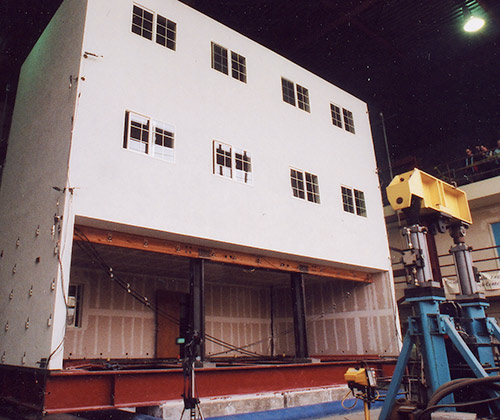Shaking table: Advanced seismic safety

A mock apartment built atop the shaking table at Richmond Field Station was demonstrated for the press and seismic researchers. (Photo by Peg Skorpinski)
Although we can’t yet predict when and where the next big earthquake will hit, the Pacific Earthquake Engineering Research Center’s shaking table has been key in determining how structures might fare during such an event. The 20’x20’ reinforced concrete table, located at the Richmond Field Station, has been helping Berkeley engineers advance seismic research since it was unveiled in 1972 as the world’s first modern shaking table.
Initially, the table shook vertically and horizontally; subsequent upgrades now allow it to move in three translational degrees and three rotational degrees, making it the largest six-degrees-of-freedom table in the country. It can be programmed to reproduce any wave form within the capacities of the system and has tested specimens weighing up to 150,000 pounds.
The table has been pivotal in proof-of-concept tests for energy dissipation devices and building systems, as well as anchoring and bracing systems — leading to improved construction standards and technologies.
Today, the computational features that control the table continue to be enhanced. Using open-source modeling and simulation software, researchers can now analyze how specific parts of a structure will perform during seismic events.
A model for shaking tables around the world, Berkeley’s table was originally designed by civil engineering professor Joseph Penzien, with the assistance of fellow faculty member Ray Clough; researcher Dixon Rea also played a significant role in the table’s early development and operation.

Researcher Dixon Rea helped with construction and operation of the shaking table in its early years.
